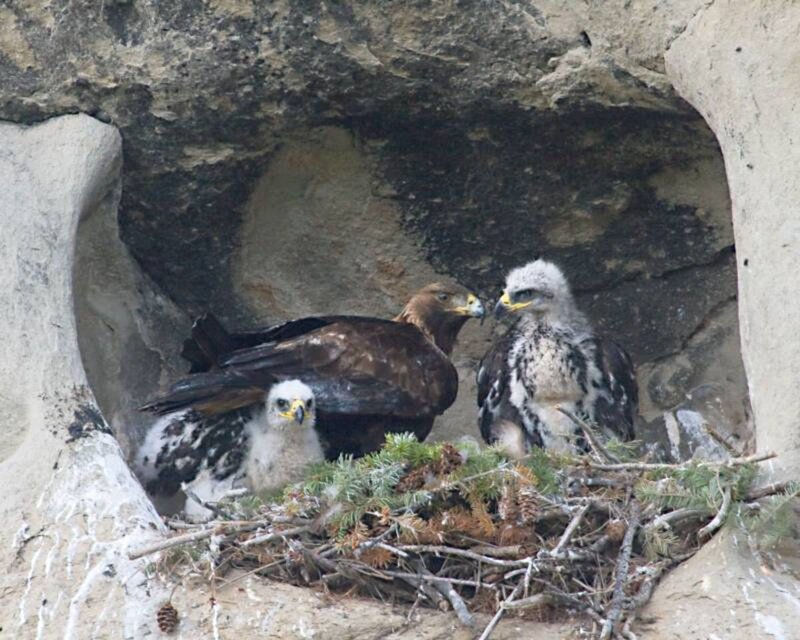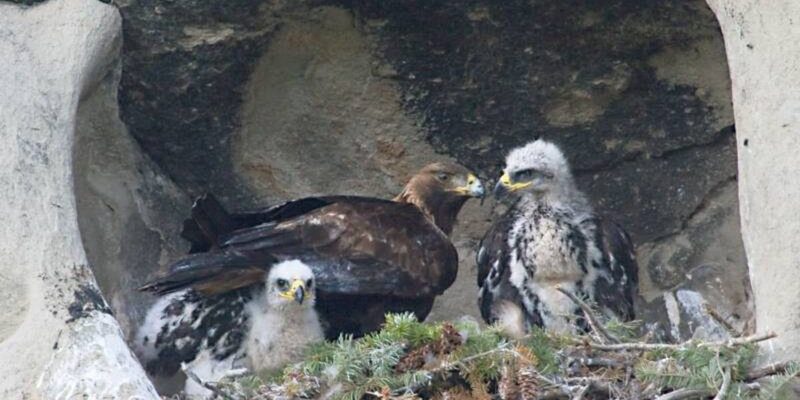
Let’s dive into the fascinating world of golden eagles. Their nesting habits might surprise you, as they are not just about laying eggs and raising chicks. Instead, these birds go through a rich lifecycle that reflects their adaptability and resilience. Here’s everything you need to know, explained simply and clearly.
Nesting Sites: Where Golden Eagles Call Home
Golden eagles are known for their impressive nesting sites, which are often located in high, inaccessible areas. Most of the time, you’ll find them perched on cliffs or tall trees, which offer a perfect vantage point for spotting prey. They prefer locations that are secluded, providing safety from potential threats.
These nests, called eyries, can be quite large, sometimes measuring over three feet in diameter! Imagine a giant pile of sticks and vegetation, all meticulously arranged by the eagles. They often reuse the same nest year after year, adding fresh materials each breeding season. This recycling behavior saves energy and time, allowing them to focus on raising their young.
Interestingly, the choice of site is crucial. Golden eagles are very selective and will often scout for the perfect location, considering factors like food availability and protection from the elements. You might be wondering why this matters. Well, having a safe and resource-rich environment significantly increases the chances of their chicks surviving.
The Breeding Season: Timing is Everything
The breeding season for golden eagles typically begins in late winter or early spring. During this time, the male and female perform elaborate courtship displays, which include aerial acrobatics and vocalizations. This is their way of strengthening their bond and showing off their impressive flying skills to each other.
Once they’ve solidified their partnership, it’s time to get down to business. They’ll lay one to four eggs, usually in March or April, depending on the region. Here’s the thing: the timing of the breeding season can vary based on climate and food availability. In some areas, golden eagles might even start nesting earlier to take advantage of abundant prey.
The incubation period lasts for about 45 days. Both parents share this responsibility, taking turns keeping the eggs warm and protected. It’s a full-time job that requires teamwork and dedication, which is vital for the survival of their future chicks.
The Hatching Process: New Life Emerges
When the eggs finally hatch, the tiny chicks are called eyas. They’re blind and covered in soft down feathers, making them look quite helpless initially. The parents are quick to spring into action. They bring food to the nest, usually small mammals or birds, to nourish their growing chicks.
You might be surprised to learn that the order in which the eggs hatch can affect sibling dynamics. The first chick to hatch tends to get the most food, which can create a bit of competition. This phenomenon is known as siblicide. While it might seem harsh, it’s a natural part of survival in the wild. The stronger chick often helps ensure at least one of them survives if resources become scarce.
As they grow, the eyas begin to develop feathers and gain strength. This period of rapid growth lasts several weeks, during which they learn vital skills by observing their parents and experimenting with their surroundings.
The Fledging Stage: Preparing for Independence
Around 10 to 12 weeks after hatching, the young eagles prepare to leave the nest. This stage, called fledging, is a critical time in their lifecycle. They start flapping their wings and taking short flights, testing their muscles and honing their flying skills.
Fledging isn’t just about getting airborne; it’s also about learning to hunt. The parents play a significant role during this time, teaching their young how to find and catch prey. You can imagine it as a crash course in survival—one that’s both exhilarating and nerve-wracking for the young eagles.
Once they successfully fledge, these young golden eagles remain dependent on their parents for a few more weeks. They’ll hang around the nest, perfecting their skills and gradually becoming more independent. This transition can be a bit rocky, with some siblings leaving the nest before others.
Where Do They Go? Post-Fledging Journey
After they’ve fully fledged, golden eagles will begin their journey into adulthood. This is where things get interesting. The young birds often wander far from their nest, exploring new territories as they search for their own home range.
During this time, they may join other young eagles, forming temporary groups. This socialization can be crucial for learning survival techniques. However, it’s also a time of vulnerability. They face various challenges, from finding food to avoiding predators.
Eventually, they’ll settle down, usually within a few hundred miles of their birthplace. Here’s the thing: finding the right territory is no small feat. They need to ensure there’s plenty of food and suitable nesting sites.
Longevity and Conservation: Protecting the Future
Golden eagles can live a long time, with some individuals reaching 30 years or more in the wild. However, their numbers have been affected by habitat loss, hunting, and environmental changes. Conservation efforts are underway to protect these incredible birds and their habitats, ensuring that future generations can continue to witness their beauty.
Many organizations work hard to monitor golden eagle populations and advocate for their protection. If you’re passionate about wildlife conservation, there are numerous ways to get involved. From donating to conservation groups to participating in bird-watching events, every little bit helps.
Understanding their nesting habits and lifecycle is just the beginning. By raising awareness, we can help protect these majestic birds and ensure they thrive in the wild.
Golden eagles are remarkable creatures, showcasing a blend of beauty and resilience throughout their lifecycle. By understanding their nesting habits and the challenges they face, we can appreciate the complexity of their existence in a more profound way.
So, next time you catch a glimpse of a golden eagle soaring through the sky, remember the incredible journey that bird has taken—from the cozy nest on a cliff to its first flight. It’s a story of survival, teamwork, and the persistence of nature. Let’s cherish and protect these majestic creatures so that future generations can enjoy the wonder of golden eagles.

